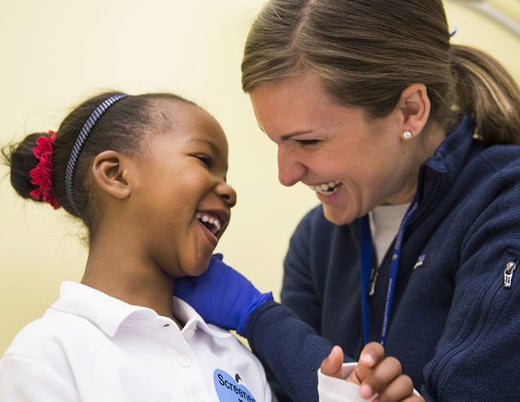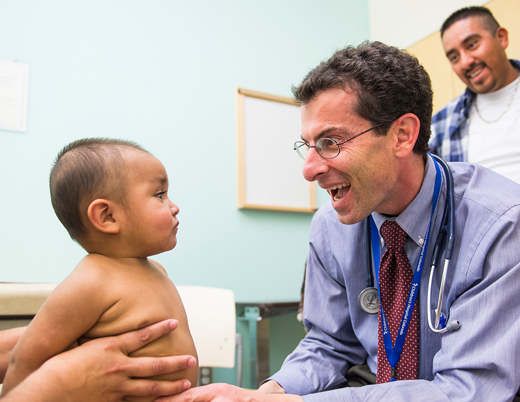Research that led to the recent FDA approval of a topical medication to treat symptoms of epidermolysis bullosa (EB) was both gratifying and humbling for Anna Bruckner, MD, MSCS, a dermatologist who is dedicated to therapeutic research on EB.
“Patients feel that even small changes are significant, and that's humbling to hear. Sometimes we need to refocus our goals when treating patients, to think about what is meaningful to them,” says Dr. Bruckner, who co-leads Children’s Hospital Colorado’s epidermolysis bullosa program. The center is one of only a handful of institutions providing advanced levels of care for EB, also known as butterfly skin disease.
Debilitating rare skin disorder that’s difficult to treat
EB is a heterogeneous group of rare, difficult-to-treat, inherited multisystem diseases affecting epithelial integrity. This causes fragility of the surface of the skin, resulting in painful blistering from the slightest friction or trauma. Patients with severe EB experience blistering on up to 30% of their body. These chronic wounds predispose patients to squamous cell carcinoma, which is a major cause of premature death.
EB is so uncommon that most pediatricians outside of a referral center may only see one patient with the disease over the course of their career. Over the past decade, Dr. Bruckner and her colleagues at Children’s Colorado have treated about 140 patients in the multi-disciplinary EB clinic.
Epidermolysis bullosa research leads to first topical treatments
The FDA approved the topical gel Oleogel-S10 (birch triterpenes), known as Filsuvez, in late 2023 for dystrophic and junctional EB, making it one of only two EB treatments available. It’s the second treatment available for dystrophic EB (DEB), a severe form of EB caused by abnormalities or deficiency of collagen VII in the skin, and the only treatment for junctional EB. The active ingredient in Filsuvez is birch triterpenes, made from birch bark powder, which is mixed with sunflower oil to form a spreadable gel.
While clinical evidence indicates that birch bark extract is an effective treatment option for patients with EB, Native Americans were known to use birch tree bark to heal wounds for centuries. Filsuvez was initially used as a burn wound treatment. Researchers in Europe, who developed it for burns, felt that there was this unmet need for patients with EB.
“What we really hope for is a kind of home run treatment so we can actually do something that changes the natural history of the disease.”
Anna Bruckner, MD
The first EB treatment to be approved by the FDA, Vyjuvek, was approved earlier in 2023. Vyjuvek is a topical form of gene therapy that delivers normal copies of COL7A1 genes to the skin, helping form anchoring fibrils that strengthen the integrity of the epidermis and dermis.
The two medications are complementary treatments. Vyjuvek is applied once per week to a limited number of wounds, while Filsuvez can be applied to all wounds on the patient's body as part of an ongoing wound care routine.
“The approvals of both these medications has given patients more hope. With rare diseases, one of the frustrating things has been a lack of research to develop therapies for a small pool of patients,” says Dr. Bruckner.
Dr. Bruckner was a site investigator in a randomized double-blind clinical trial of Filsuvez published in British Journal of Dermatology in January 2023. The study included 223 patients from around the world and resulted in 41.3% of patients with first complete target wound closure within 45 days, compared with 28.9% in the control group. The treatment was well tolerated.
Filsuvez reduces pain and improves symptoms and quality of life. While the medication isn’t disease-modifying, providing relief from EB’s debilitating symptoms proved to be what patients actually want. “It helps patients make their wound heal easier, reduces pain and reduces how often that they have to change their bandages, so patients can live more normal lives,” says Dr. Bruckner.
With further research, Dr. Bruckner anticipates the mechanism behind this medication could be beneficial for a whole range of different types of wounds.
Gene therapy research to cure EB
Dr. Bruckner’s career has been dedicated to EB research, including gene therapy. The disease is rare, but Children’s Colorado is the hub of a multi-site clinical research network that includes data from nearly 1,200 patients. “What we really hope for is a kind of home run treatment so we can actually do something that changes the natural history of the disease,” says Dr. Bruckner.
Ultimately, Dr. Bruckner hopes her research will contribute to a disease-modifying treatment that’s not just a patch for the skin. For now, though, she and her patients are celebrating the improvement in quality of life that comes with the FDA approval of Filsuvez.
Featured researcher

Anna Bruckner, MD, MSCS
Section Head, Pediatric Dermatology
Director, Pediatric Dermatology Fellowship
Children’s Hospital Colorado
Professor of Dermatology and Pediatrics
University of Colorado School of Medicine





 720-777-0123
720-777-0123










